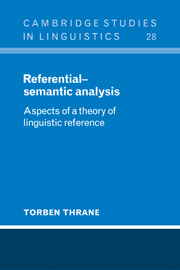7 - REFERENTIAL FUNCTIVES
Published online by Cambridge University Press: 06 August 2010
Summary
‘Referential functive’ defined
In this the final part I shall apply the theoretical framework developed in Part II to selected areas of English nominal composition.
From the very first inception of the research reported on in the present work my focus of attention was on pronouns, and it was my original plan ‘simply’ to account for pronominalization in English, essentially on the basis of a substitution model à la Harweg (1968) and Crymes (1968); several – abortive – attempts were made to come to grips with what Hjelmslev calls ‘la nature du pronom’ in this way. The present work may be read as the testament of my disillusionment with such an approach. From being traditionally a comparatively clearly delimited, closed class with a rather small membership, the class soon became invaded from all sides, by modal verbs (Crymes), by definite NPs (Harweg) and by determiners (Lyons 1973; Sommerstein 1972; Sørensen 1958). The result was that ‘the pronoun’ gradually receded to the point of vanishing (Postal 1966), hiding behind all manner of phenomena which all seemed to have one thing in common: referentiality. From being a major class within – apparently – easy access for investigation, it became a minor class virtually inaccessible.
The shift in viewpoint from ‘pronouns’ to ‘referentiality’ as the basic notion thus shifted the approach in the direction of Collinson (1937) with its basic appeal to ‘indicaters’. Although this is in many respects an interesting work I think it is fair to say that it is somewhat impressionistic and too intuitive to constitute a principled basis for a general theory of linguistic reference.
- Type
- Chapter
- Information
- Referential-Semantic AnalysisAspects of a Theory of Linguistic Reference, pp. 125 - 156Publisher: Cambridge University PressPrint publication year: 1980



